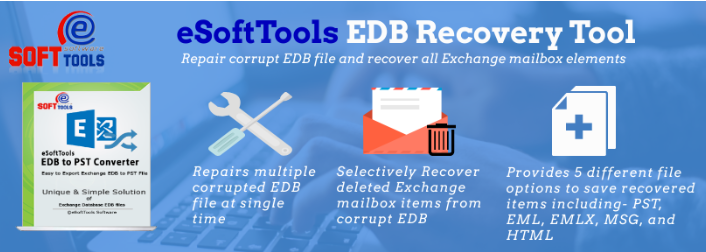If your company uses Microsoft Exchange Server, you are aware that email operations are suspended due to corruption or failure of the Exchange database (EDB). Exchange is unable to mount databases and send emails when an EDB file is corrupted or useless. Frequently encountered difficulties related to EDB files include faults during the unclean shutdown, mounting issues, and file crashes following events like hardware malfunctions or power outages. In situations like this, having a trustworthy Exchange EDB recovery solution is crucial to helping restore mailbox data and maintain company operations.
This post analyzes the top five programs available worldwide to repair corrupted EDB files and recover exchange mailbox contents, such as calendars, contacts, and emails. These best Exchange EDB recovery solutions all have different recovery needs in mind, but they all have the same fundamental functions, which include search, selective restoration, EDB/mailbox repair, and parallel mailbox recovery. Thus, enterprises may ascertain the suitability in terms of infrastructure, requirement, available quantity of money, and other aspects starting from EDB repair solutions, like Stellar Repair for Exchange software, to all-encompassing ones, like Ontrack. Email uptime and regulatory compliance depend on having a top-notch EDB recovery program.
1. Stellar Repair for Exchange – Comprehensive EDB Recovery Tool
One of the most potent EDB recovery tools, as acknowledged by Microsoft MVPs, is Stellar Repair for Exchange. It repairs severely damaged and unmountable EDB files so that all mailbox contents may be recovered without any data loss. Important talents consist of:
Retrieves erased email accounts from EDB files
Restores contacts, tasks, calendars, diaries, emails, attachments, and notes
Exports to PDF, HTML, RTF, MSG, and EML
immediately exports mailbox data to Office 365 or real Exchange
recovers from corrupt shutdowns, failed mounting attempts, and Exchange server crashes
Granular and complete mailbox recovery are supported.
With an interface akin to Outlook, intelligent keyword searches
Exchange 2019, 2016, 2013, 2010, 2007, 2003, and 5.5 EDB files are supported.
In order to extract as much data as possible from the damaged Exchange databases, the program uses advanced scan techniques when the Exchange databases are not accessible or ESEUtil repair is ineffective. For Exchange organizations, it is very cost-effective because of its low capital intensity.
2. Quest Recovery Manager for Exchange – Rapid eDiscovery and Migration
Quest Recovery Manager is intended to expedite eDiscovery, migration, and Exchange data recovery processes by up to 74%. Admins may concurrently search, evaluate, and retrieve mailbox items from numerous data sources from a single console. Notable attributes include:
Federated search over current and archival mailboxes, PSTs, and EDBs
Exports to Office 365, Exchange mailboxes, MSG, EML, and PST
Tasks for automatic and scheduled data export and search
Preserves certain data without requiring complete backups.
Quest’s software streamlines migration efforts and allows firms to respond quickly to legal inquiries, internal investigations, and compliance requirements thanks to its federated search.
3. Ontrack PowerControls Suite – Exchange, SharePoint & SQL Recovery
A complete package that meets the demands of Exchange, SharePoint, and SQL data recovery is Ontrack PowerControls. With the use of robust searches, its Exchange edition enables the granular restoration of specific mailboxes and email messages from backups. Fundamental talents are:
Searching at the item level and recovering from Exchange backups
locates and exports eDiscovery custodian mailbox information.
PST exports for archives and e-discovery
repairs damaged SharePoint lists, sites, and libraries quickly
recovers tables from SQL databases for use in development and testing
4. Digiscope – Integrated eDiscovery and Disaster Recovery Tool
Digiscope is a flexible eDiscovery and disaster recovery solution for Exchange settings. It enables the fast and accurate restoration of mailboxes, contacts, emails, and other data from offline EDBs, PSTs, live Exchange servers, and backups. The salient features are:
eDiscovery is used to search exchange data sources.
mailbox contents partially restored but not entirely
Exporting Exchange data and moving it to new servers or PSTs
mailbox import/export functions for archives and backups
Digiscope’s integrated approach offers extensive capabilities for disaster recovery, eDiscovery, archiving, and migrations all in one coherent solution, reducing the need for multiple tools.
5. Veeam Explorer for Microsoft Exchange – Restores from Veeam Backups
As the name suggests, Veeam Explorer for Microsoft Exchange is made especially to export and restore Exchange data from Veeam backup sources, such as Veeam Backup & Replication. Important characteristics are:
Return email accounts and mailboxes from Veeam backups
Compare the production environment with the backup data.
Locally save the necessary Exchange objects from backups.
Users receive immediate backup item distribution via email
Full-server and granular restoration from Veeam backups
Simplified browsing and searching inside backup files
It offers mailbox recovery, comparative analysis, eDiscovery, and export capability appropriate for Exchange enterprises utilizing Veeam backup solutions, despite being tailored for Veeam backup settings.
Conclusion
For a business, managing an Exchange database disaster may be extremely stressful. Missed conversations, decreased productivity, and even compliance issues result from email outages. This makes it imperative for companies using Microsoft’s email servers to have a reliable Exchange EDB recovery solution. Although certain repair capabilities are provided by native Exchange tools, extensive scanning, quick issue resolution, and versatile recovery choices are features of third-party software that goes above and beyond. Each of the top five vendors—Quest Software, Ontrack, Digiscope, Veeam, and Stellar Data Recovery—brings a different value proposition to the table.













